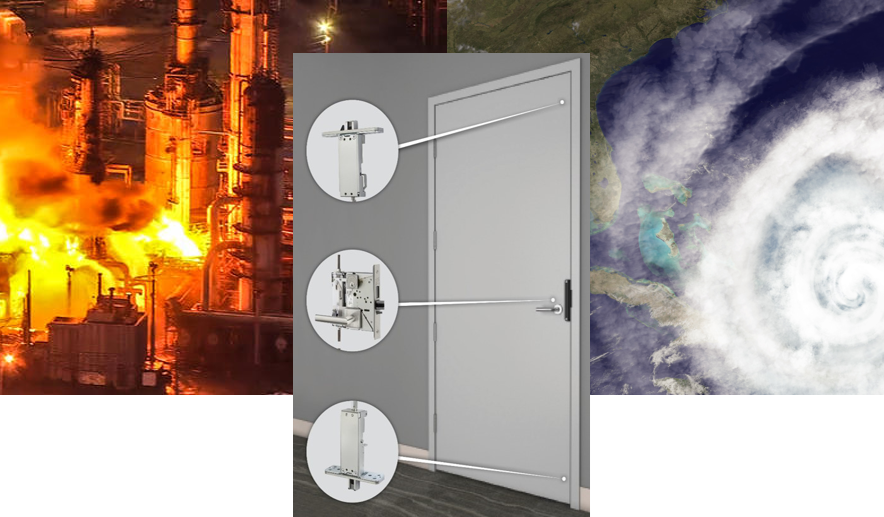This post is sponsored by ASSA ABLOY
The Atlantic Hurricane Season is nearing its peak, according to meteorologist Danielle Banks. A combination of numerous tropical waves, increasing ocean temperatures, weakening dry air and changes in wind shear will lead to an uptick in activity. Meanwhile, on the other side of the Atlantic, recent explosions in Beirut, Lebanon, have spurred renewed focus on the importance of blast resistance in structures all over the world. Hurricanes and explosions present a dual threat to critical infrastructure, particularly in petrochemical, government and military applications.
To help companies and entities in these sectors ensure protection, one company, ASSA ABLOY, offers a novel door and hardware assembly. It is a multi-point lock with three latching points (top, bottom and center) that has been tested for extreme levels of resistance. To learn more about the product, SmartBrief reached out to Marc Stroot, manager of Specialty & Integrated Solutions at ASSA ABLOY. The following Q&A has been lightly edited for clarity and style.
What makes the lock unique?
The lock is unique in that it has been tested and survived both blast and extreme hurricane conditions. Many products in the market are manufactured to withstand one or the other, but rarely both.
How is the technology installed and how long does it take?
The door is manufactured with a lock cassette and rods that are factory installed. At the installation site, the lock simply snaps in place into the cassette.
Can you explain how the product is manufactured and tested?
Testing for hurricanes is certified by Underwriters Laboratories at an approved lab. The process involves using both a positive and negative pressure to replicate a barometric pressure present during a storm. It also undergoes an impact test where a specified 2×4 is shot from a cannon at specific impact areas on the door and lock. The relevant test standards are: ANSI A250.13, ASTM E330, ASTM E1886, ASTM E1996, TAS-201, TAS-202, TAS-203-large missile impact.
Testing for blast resistance is conducted at a third-party laboratory. It is done in a blast shock tube in which the assembly is exposed to pressures which might be created from an explosion. The test standards employed are: UFC 4-010-01 DoD Minimum Ani-terrorism standards and ASTM 2927-12 Response Categories 1 (no damage) and 2 (damaged but operable) following a blast. Finally, the assemblies undergo standard fire testing, which is also certified by Underwriters Laboratories. Our door assembly was shown to deliver up to three hours of fire protection.
Your product sheet says the assembly “offers a full range of mechanical and electromechanical functions and options.” What specifically are those functions and why are they important?
With today’s heightened security requirements, we designed this lock to integrate with access control platforms to improve building security. The doors can then be monitored to ensure they operate as expected.
Do you have a specific example of a military base, petrochemical refinery site or other infrastructure application where the assembly has proven itself?
Today we are in the process of supporting multiple projects, from military bases in Florida to refineries in Texas and many facilities in between. ASSA ABLOY introduced this product to the market only a few weeks ago and we are currently bidding on several projects where blast and hurricane resistance is required. These include Hurlburt Field AFB, Thomas Hill Power Plant and North Equipment Airlock, among others.
What feedback have you received from clients? What has surprised them about the product?
Prospective customers and design architects are excited to hear there is a door assembly available that can meet both of these critical life/safety building requirements and that they integrate seamlessly with their buildings’ access control platforms.
To learn more about this product, download the white paper.
Marc Stroot has been with ASSA ABLOY for 10 years, currently serving as the Manager of Specialty and Integrated Solutions for the company’s Door Group. Among his other responsibilities, Marc provides technical support to end users, architects, spec writers, sales teams and project managers, researching and offering strategic solutions for some of their most complex technical challenges. He also participates in the design and testing of new products and helps introduce them to the company’s sales teams and customers. Prior to his current position, Marc managed the Engineering department at Security Metal Products, a maker of high-security custom commercial doors and frames, before it was acquired by ASSA ABLOY in 2010. Before that, he served as project manager for a Colorado-based company. Marc studied Mechanical Drafting and Design Technology at Alexandria Technical College in Alexandria, MN. His deep understanding of doors and frames, and his familiarity with both the manufacturing and end user sides, enables him to help customers find the right solution for their project specifications and their budget.
